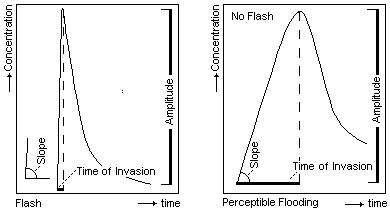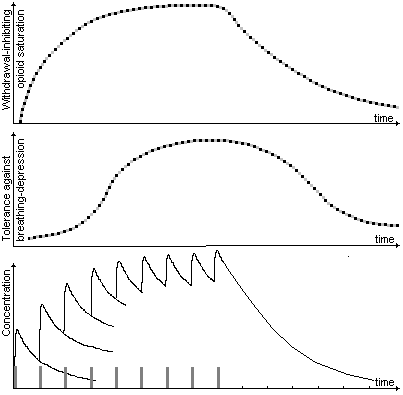
9 Relevance of Pharmacological Basics
9.1 Invasion: The ‘Flash’ called delight and the ‘perceptible feeling of flooding’
Th equality of the start of effect is mainly a question of how the substance is consumed.

Fig.23: Flash and Flooding
Fast-working substances need only a short invasion time to fllod the site of action. When opioids, in larger doses, flood within a short time, and in comparison to drugs already present the addict feels delight, the so-called flash. The Slope (the steepness of the increase in concentration in the central nervous system) and the relative Amplitude (the relatively large increase in concentration in comparisonto the curve from the previous consumption) determine the subjective extent of the flash effect. The Flash effect is therefore not an absolute effect but the perception of a change in effect; the extent of the flash effect is determined by the relative change in effct. Hypoxy plays a possible role in the flash effect.
During intravenous injections and certain inhaling techniques (Chase the dragon and with a small water pipe) is a flash possible to achieve. Depending on the inahling technique can the right amount be consumed in one go an done feels a flash, or the dose is distributes over more than a few inhalations (Sugarettes or large water pipes) and the result is a perceptible flooding. When the the invasion time more than a few seconds but less than a quarter of an hour lasts then one feels no flash but a flooding feeling. Very dominant is the feeling of flooding when smoking sugarettes, less when swallowing Methadone and no flooding-feeling is felt by intestinal delayed reaction Retard-preparations of Opioides (see Chapter 9.5).
9.2 Evasion: Sensation of Changes during the Day and Steady-State
The length of effect if mainly a property of the substance. For practical purposes, it equals the biological half-life.
Methadone has a long half-life and largely accumulates through daily consumption. Methadone consistently blocks the effect of endogenic opioid Peptides. Even though a causal connection has not been proven, the desire for life and Appetenz behaviour is constantly numbed. Pleasant as well as unpleasant feeling-highs are possible. Methadone produces a kind of cotton wool shell, a life in the protected tank: no orgastic but also no painful feelings; a pleasant misery without any overwhelming feeling for life but also without pain and sorrow.
Morphine- or Heroin-Retard-Preparations, with their shorter half-lifes in comparison to methadone cause a perceptible daily pace of the Opioid effect. It is possible that endogenic opioid Peptides can unfold their effect. Vigilance, Libido and Potency are not constantly numbed. The subjective difference between a life in Steady-State and a perceptible Tagesgang of Opioid effect is large.
Substances with a biological half-life of 3 – 9 hours seem to be the most attractive for the addicts: these are substances, which transmit a opioid effect and therefore a perceptibleTagesgang of the Opioid effect. A perceptible Tagesgang of opioid effect can improve the acceptancy of opioid prescription z.B. in comparison to oral methadone. The effect-dynamics of Morphine-Retard-Preparations transmit such fluctuations in the vigilance and appetence, also a noticeable Tagesgang of the subjective energy and therefore a larger spectrum of feelings.
Without a doubt, it would be the best if one did not consume any(more) opioids. We have to learn that only the minority of addicted patients in a certain moment, can give up i.e. today. The attraction of diversified prescription of opioids is for the addicts and clinically for the treatment, a crucial mass.
Forms of application, frequency of application and the substance used makes the consumption of opioids more or less attractive for the addict. The forms of consumption are almost more important than the properties of the substance itself. The attraction of the possible euphoria-potency is not to be placed equal to the properties of a substance (Gezondheidsraad 1995). Subjectively crucial for the drug-addict is the chronological course of the concentration of effect. There is a noticeable flooding between the Flash and the Steady-State and the perceptible daily pace of the Opioid effect.
The attraction of opioids is determined on one hand by the Effect-slope (Slope) and on the other hand, by the length of effect. Simplified, one could say that the attraction for the addict, of a certain form of consumption of an opioid results from the flooding velocity and the half-life.
With slow working substances such as Methadone, one can gain an impressive number of opioid addicts into treatment and they can be partly prevented from going to the illegal market. The attraction of a daily intake of methadone lies in the ability of methadone to bond and take effect on the opioid receptors in the Rewarding system, thus preventing any signs of abstinence: the hunger for opioids is quenched with peroral methadone in that there no cold-turkey symptoms are felt. The attraction of peroral methadone is, without a doubt, limited. The memory of more, other secondary strengthening effects such as injecting and the flash, but also desires and needs which led to the addiction , remain. Swallowed methadone transmits subjectively a quiet flooding and produces through accumulation throughout the day only a slight fluctuating effect: in fact, a Steady-State.
Consumption patterns are also determined and induced, along with pharmaco kinetic and pharmaco dynamic, through:
In order to be able to describe the differences in consumption pattern through pharmaco kinetic and pharmaco –dynamic sizes, the following qualitative terms such as Flash, flooding and noticeable Tagesgang or Steady-State were introduced. After the invasion the subjective course of effect is determined through the drop in concentration, the evasion through the opioid molecules at the site of action and therefore practically independent of the form of consumption and for example, the same by a one off inhalation as well as by a one-off injection. The frequency of consumption when consuming opioids is determined mainly by the properties of the substance and explain themselves through the effect-half-life. We call the ability of an opioid dose to avoid/lessen cold-turkey symptoms, withdrawal preventing opioid saturation. As soon as the opioid effect drops, below a certain point, on the opioid receptors, cold-turkey symptoms in comparison to the different opioids are felt (see Abb.24, 26, 27). This mass is important for diversified opioid prescription (Equivalence dosage see Chapter 11.1).

Fig.24: Chronological Course of the Concentration-Effect, Tolerance in Relation to Breathing Depression and Withdrawal-Inhibiting Opioid Saturation in a Person, Previously Abstinent, when Starting and Reducing Methadone
The subjective effect through invasion of the opioids and the flash is mainly dependent on from the form of consumption but also on the frequency of consumption. Subjectively crucial is the slope and the relative amplitude of the concentration slope. The Opioid effect is numbed by previous opioid accumulation and through the tolerance to the substance. Previous opioid consumption decreases the relative amplitude in the change in concentration at the site of action and therefore numbs the Flash-Effect of later opioid consumptions. The more often and the more opioid is consumed, the more numbed the effect of new opioid consumptions will be. This is difficult for the consumer to understand
Steady-State-Consume is, outside of the prescribed, controlled offer of opioids, only experienced by the minority of opioid addicts. Our patients misjudge the effect of the Steady-State-Consume and nearing of the maximal-effect dosage as qualitative defect of our heroin.
A few patients in heroin-supported treatment complain of the ’lack’ of effect and the flat flash. They presume that another or a synthetic heroin is used and that the heroin from the streets is better. The patients injected irregularly and with varying doses whilst on the streets. Smaller heroin effects, poor flash experiences varied with (sometimes risky) strong effects from heroin, , after hours and days, signs of cold-turkey and a decrease in tolerance. One pays for the ’Super-flash’ from the streets with usual and always repeating suffering, fear and cold-turkey.
Long lasting opioids such as methadone and LAAM numb the Flash effect an the noticeable flooding through a large accumulation. In comparison, the pre-consumption of Morphine- or Heroin-Retard-preparations is less noticeable, the more noticeable are the effects from smoking or injecting heroin.
Concentration effects, tolerance formation and opioid saturation do not have a parallel course. It is possible to have a deadly overdose with a second or third intake of methadone due to the obvious accumulation.
The smaller accumulation with heroin and other opioid agonists could possibly the observations made by Marks (1992) , that in Great Britain there were less sudden deaths with heroin-supported treatments than with methadone. The doses could be increased day to day with the short lasting opioids due the slight accumulation. (Seidenberg 1996).